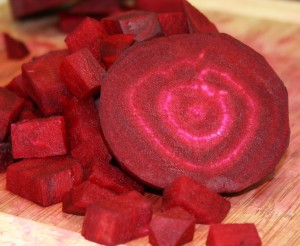 Consider the beet. Partially hairy and totally gnarly, its dark ready body topped with deeply veined green leaves lined in red, this homely vegetable, fat and bulbous, can be termed one of the best all around food to eat.
Consider the beet. Partially hairy and totally gnarly, its dark ready body topped with deeply veined green leaves lined in red, this homely vegetable, fat and bulbous, can be termed one of the best all around food to eat.
Eaten raw, steamed, grilled, boiled, roasted, pickled or shredded, the humble beet packs a powerful punch to the health of the body.
Go around to any juicing bar, and the bright red beet juice filled with antioxidants, vitamin C and potassium is making its way down gullets daily.
Evidently the word is out that beets rock alongside its other chenopod family members, chard and spinach.
With folate and manganese as a prime value, beets have high levels of betaine to make a heart healthy venture in the body. Betaine helps lower homocysteine levels, a sign of unwanted inflammation and risk of cardiovascular problems like atherosclerosis.
Beets also have phytonutrients to provide anti-oxidant and detoxification support. Yellow beets contain more carotenoids, and red beets more betalains. Besides being a good source of dietary fiber, harboring free radical scavenging copper and the lovely mineral magnesium for bone health, beets contain iron and phosphorus to keep the body’s energy going.
But after all being said in the avenue of health, beets pose a big mystery to those who wonder how exactly does one cook them?
Though eaten raw, whether shredded in salads or juiced keeps all the important vitamins and nutrients intact, the best possible way to cook a beet is steaming it. Keep in mind the longer a beet is heated, the less betalains available. Cooking diminishes the phytonutrients, so cut in quarters and steam only for 15 minutes for medium size beets. They are fully cooked after a fork can easily be inserted.
When ready, plop them on a cutting board and, with a paper towel, gently rub the skin off. Mix balsamic dressing with garlic, basil, dill, chives, and feta cheese with a little cracked pepper for a delicious salad, or use as a side dish for an entrée.
If you add a little lemon juice while cooking, the beets will turn a brighter red; for more purple add a pinch of baking soda. And don’t add salt while cooking, or the pretty red color of the beets will fade. Only salt after if needed.
Borscht, a Ukranian favorite, is a delicious way to get the fabulous nutrients from the beets and probably the reason there are so many Russian centarians!
Take 4 large chopped white onions, 4 peeled grated carrots, 3 medium grated beets, 4 large cloves of garlic, 2 large chopped tomatoes, one teaspoon of lemon juice and saute in a frying pan for 5 minutes, then cover and let sit. Fill a large pot half-way with water and when water is boiling add the two medium peeled chopped potatoes to the water and wait 3-4 minutes. Then add half a head of shredded cabbage and wait 2 minutes. Then add the contents of the frying pan, some chopped parsley, dill and a bouillon cube, bring back to a boil, turn off heat, cover and let set for about 2 hours. The beautiful bright red soup is served hot or cold with a dollop of sour cream.
For an added boost, sauté the beet greens with garlic and serve on top of toasted sourdough drizzled with olive oil to eat along with the borscht.
Though many might opt for canned beets, nothing compares to the taste when cooking the roots yourself.
Contact Gina Dostler at Ima_gina_tion@yahoo.com.





Eating beets may cause “beeturia,” the reddening of urine or stool.
Rudy Silva has a degree in Physics and is a Natural Nutritionist.
This is another big reason for getting the body detoxicated.